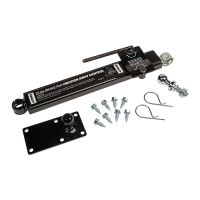Installation instructions:
Most weight distributing ball mounts come equipped with a sway control
ball plate attached. If so, attach the sway control ball to the ball mount using the
hole provided. If no sway control ball hole is provided, then use the ball mount bar
provided and weld to the ball mount as shown in figure 1.
Measure 24" straight back from the center of the coupler to the right hand
side of the trailer frame to determine the location of the trailer tongue ball plate.
The trailer tongue ball must be centered on the 24" measurement. Transfer the
punch holes from the trailer tongue ball plate to the trailer frame and drill
11
/
32
"
holes. Attach the trailer tongue ball plate and the trailer tongue ball to the trailer
frame using the self tapping screws provided. See figure 2.
Warning!
The sway control CANNOT be used on trailers with surge brakes! DO
NOT speed up if sway occurs. Sway increases with speed. If sway continues,
stop the vehicle and inspect all equipment and trailer loading until the cause
has been determined and corrected. Trailers should be loaded with heavy
items on the floor, in front of the axle. The load should be balanced side to side.
Tongue weight should be 10-15% of gross trailer weight for most trailers.
Insufficient tongue weight or tail heavy trailers can cause sway. When towing
in slippery conditions, such as wet, icy, gravel or snow covered roads, the sway
control must be removed. Never paint or lubricate the slide bar.
If the trailer is 24' or longer, the use of both a right hand (item #34715) and
left hand sway control (item #37498) is recommended.
Warning! Check all mounting bolts and attachment points for the sway con-
trol, hitch and related components every 500 miles, or per the manufacturer's
instructions. Whichever is more frequent.
Use:
Hook up the trailer to the tow vehicle. Lubricate the threads on the handle
with a drop of oil. Attach the socket on the slide bar to the sway control ball on the
ball mount. Secure in place, using a spring clip. Turn the On/Off handle 3 turns
counterclockwise to release tension. Place the socket on the main body onto the
trailer tongue ball. Secure in place, using a spring clip.
Turning the On/Off handle clockwise, tighten firmly until the handle is par-
allel with the main body. With a second person watching the sway control and
trailer, slowly back the trailer in both directions to a jackknife position and check
that the sway control does not hit the bumper or trailer frame and that it does not
become fully compressed or come apart.
If any of these items occur when jack-
knifed, the sway control must be removed while backing.
Road and weather
conditions, loading and
design of the trailer as well as power steering, wheel align-
ment and the oscillation point of the tow vehicle and trailer all affect towing char-
acteristics.
Starting with the factory preset tension, road test the sway control. If this is
not enough sway control, then adjust the break tension screw
1
/
4
turn clockwise.
Road test again and repeat (if necessary) until proper sway control is achieved.
Larger or heavier trailers or broad sided trailers may require the use of two sway
controls. After a 1,000 mile break-in period, remove the slide bar and clean it using
a wire brush or steel wool. The slide bar should then be cleaned every 10,000 miles.
Check all mounting bolts and attachment points for the sway control, hitch and
related components every 500 miles, or per the manufacturer's instructions.
Whichever is more frequent.
•
Warning, by towing a trailer, you change the handling characteristics of the tow vehicle.
•
Warning, short wheel base vehicles may induce sway when towing a trailer. USE EXTREME CAUTION.
•
Any welding should be done by a qualified welding shop.
• For units up to 24’ use 1 sway control, for units 24’ and longer 2 sway controls are recommended
#34715 RIGHT HAND HUSKY SWAY CONTROL

